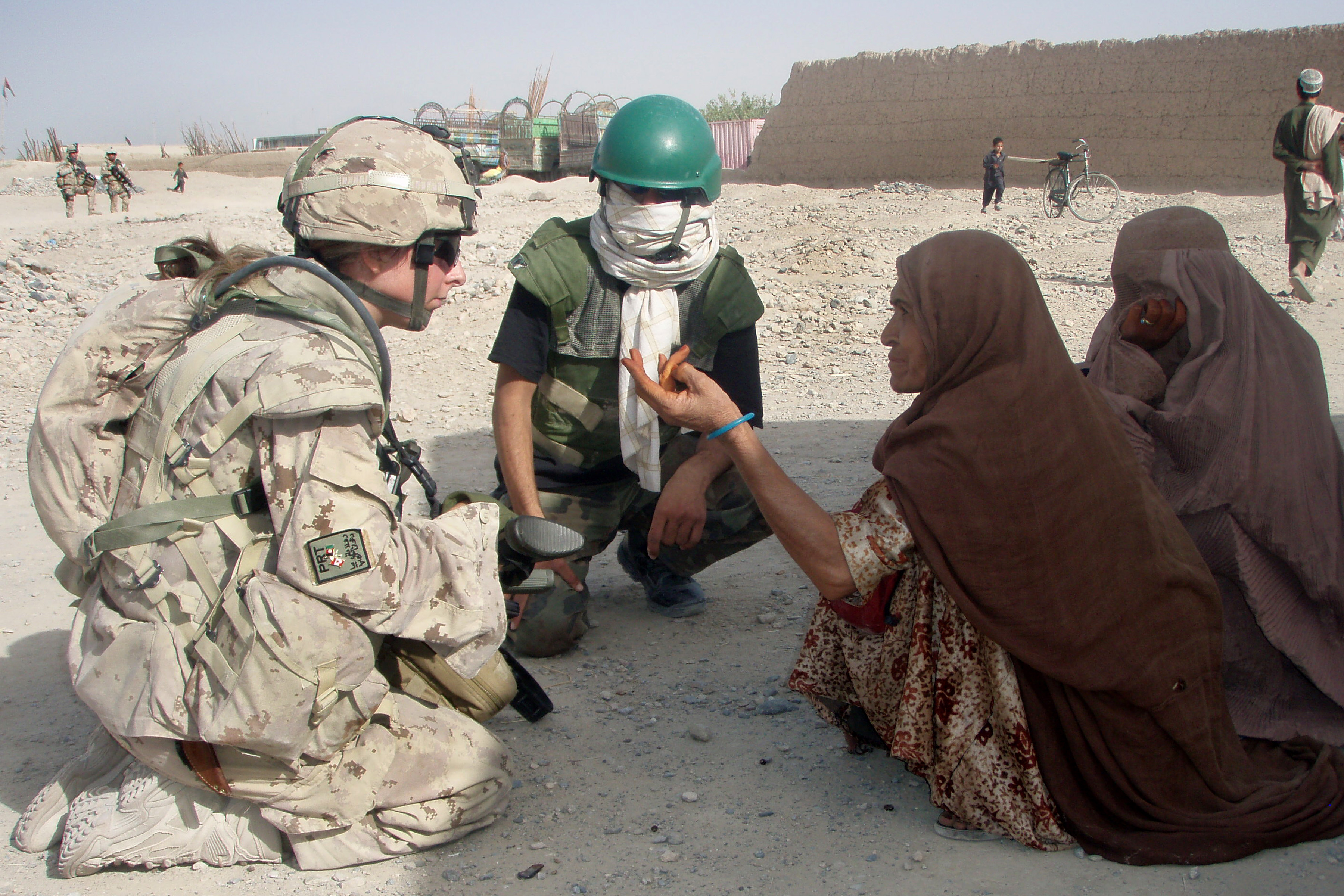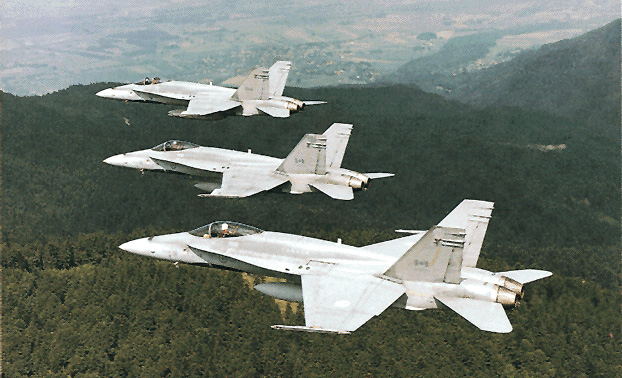Canadian Armed Forces defend Canada and its interests throughout the world. They maintain the equipment, weapons, and troops necessary to protect Canada and to provide humanitarian assistance in Canada and worldwide. In addition, the forces contribute to international peacekeeping and security operations. The Canadian Armed Forces are made up of about 100,000 men and women volunteers in active service and reserves.

Organization.
An officer called the chief of the defence staff (CDS) commands the Canadian Armed Forces. The CDS is the chief military advisor to the prime minister of Canada on military matters. The governor general of Canada appoints the CDS on the recommendation of the prime minister.
The Canadian Armed Forces consist of the Regular Forces, who are always on active duty, and the Reserve Forces, who supplement the Regular Forces when necessary. The Canadian Armed Forces include three large defense organizations: (1) the Canadian Army, (2) the Royal Canadian Navy (RCN), (3) and the Royal Canadian Air Force (RCAF).
The Canadian Army’s primary tasks are to protect Canada and to defend North America in cooperation with the United States. The Canadian Army also participates in overseas operations, antiterrorist operations, and peacekeeping missions. It aids provincial and territorial authorities in dealing with natural disasters. It maintains three regular combat mechanized brigade groups and several reserve combat brigade groups. The Canadian Rangers, who serve in the far north, are members of the Reserve Forces.
The Royal Canadian Navy protects Canada’s coastline and works with Canada’s allies to defend North America. The Navy defends Canadian waters against illegal fishing and environmental damage. It also supports international peacekeeping missions and humanitarian assistance projects, as well as patrols against piracy and drug trafficking. In addition, it maintains security through the North Atlantic Treaty Organization (NATO), a military alliance consisting of Canada, the United States, and most European nations. The Canadian Navy operates closely with the United States Navy. A Canadian frigate normally accompanies U.S. carrier strike groups (CSG’s), which conduct air strikes, as anti-aircraft and anti-submarine protection. The Navy’s operations are conducted from two major bases, in Halifax, Nova Scotia; and Esquimalt, British Columbia. The Naval Reserves assist the Navy.
The Royal Canadian Air Force is charged with surveillance and control of Canadian airspace. It shares in the joint defense of North American airspace with United States forces through the North American Aerospace Defense Command (NORAD). The Air Force provides air support to the Army and Navy, and it transports Canadian Armed Forces personnel and equipment throughout the world. The Air Force is made up of 14 wings. A wing is a group of operational and support units under a single tactical commander. The Air Reserves assist the Air Force.
Support organizations under the control of the Department of National Defence aid the Canadian Armed Forces. Defence Research and Development Canada provides the Department of National Defence and the Canadian Armed Forces with technical and scientific services. The Communications Security Establishment works to keep telecommunications, electronic communications, and computerized systems secure. It represents Canada in the Five Eyes alliance, an intelligence sharing alliance between Australia, Canada, New Zealand, the United Kingdom, and the United States. The National Search and Rescue Secretariat coordinates the activities of government, private, and volunteer organizations that provide search and rescue services.
Weapons and equipment.
The Army’s vehicles include tanks, wheeled armored personnel carriers, heavy trucks, and Mercedes G-Wagons for light transport. Its artillery includes howitzers that can fire shells guided by the Global Positioning System (GPS) and lighter cannons.
The Navy operates frigates; Maritime Coastal Defence Vessels, usually crewed by Navy reservists; and diesel-electric submarines. The Navy also has many smaller vessels and training ships.
The Air Force flies CF-18 Hornet fighter-bombers, CP-140 Aurora patrol aircraft, and smaller training aircraft. Transports include the CC-115 Buffalo, CC-130 Hercules, CC-144 Challenger, and CC-177 Globemaster heavy lift air transporter. Helicopters include the CH-148 Sikorksy Cyclone, a shipboard helicopter for antisubmarine warfare and other uses; the CH-147F Chinook, a heavy lift helicopter; and the CH-149 Cormorant, for search and rescue. 
Recruitment and training.
Officers in the Canadian Armed Forces may receive their commissions in one of two ways. The first is to enter the Canadian Armed Forces after graduating from a university and agreeing to active service for five years. The second way is to graduate from the Royal Military College of Canada in Kingston, Ontario. Graduates receive a bachelor’s degree and a commission as an officer in the Canadian Armed Forces. A bachelor’s degree has been a requirement for officers since the late 1990’s.
Noncommissioned recruits must have at least a 10th-grade education and enlist for three years. Recruits attend basic training, which is followed by occupational training courses. A Canadian citizen must be at least 18 years old to enlist, with some exceptions.
History.
During colonial days, Canada’s defense was the responsibility of the governments of France and Britain (now also called the united Kingdom). Colonial militias made up of citizen soldiers supplemented the government forces. The Dominion of Canada was formed in 1867, and Britain removed its army from Canada in 1870 and 1871. The colonial militias then assumed responsibility for the defense of the new nation. In 1871, the first units of what would become the Canadian Army were organized. The Royal Canadian Navy was formed in 1910, and the Royal Canadian Air Force in 1924.
Canada’s military forces fought under British command in the Anglo-Boer War of 1899-1902. During World War I (1914-1918), Canadians formed an entire corps with four divisions. The Canadian Corps fought with the Allied forces under British command, but it had more autonomy than a regular British corps. In 1918, Sir Arthur Currie became the first Canadian commander of the Canadian Corps. More than 1 million Canadians served with the Allied forces during World War II (1939-1945). During that war, the Royal Canadian Navy played a major role in the Battle of the Atlantic . The Canadian Army fought in Italy and in the Normandy region of France.
Canadian troops fought with the United Nations (UN) in the Korean War (1950-1953). The Air Force fought in the Persian Gulf War of 1991 . In 1999, the Air Force took part in NATO air strikes against Serbia (see Kosovo ). The Air Force also participated in an international effort to oust Libyan leader Mu’ammar Muhammad al-Qadhafi in 2011, and in operations against the Islamic State terrorist group in 2015. In addition, the Army and Air Force served in the Afghanistan War (2001-2021). Canadian troops have served in many UN peacekeeping operations since 1957, when they joined such an operation in the Sinai Peninsula and the Gaza Strip. However, few Canadians have served with UN forces since the mid-1990’s.
In 1968, Canada’s government renamed its armed forces. The Army became the Mobile Command. The Navy became the Maritime Command. The Air Force became the Air Command. In 2011, the government reinstated the original names.
